449 Search Results for VISUAL SUPPORTS
July 30, 2018
by Carole Zangari -
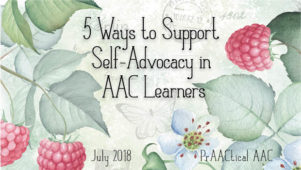
self-ad·vo·ca·cy: self ˈadvəkəsē/ Noun: the action of representing oneself or one’s views or interests. —————————- Empowering AAC learners to advocate for themselves may be one of the most important and impactful things that we can do to help them stay safe and achieve their goals. Here are some ways we can support that process. Provide messages for self-advocacy behaviors: It’s hard to represent your own interests without the appropriate set of vocabulary and messages. Words and prestored messages for protesting and rejecting are essential (e.g., No; Stop; No, thank you; I don’t want to). In addition, consider adding messages which allow the communicator to express disagreement or negative opinions (e.g., I don’t like it; I don’t think so; That doesn’t work for me; This is unfair; That’s disrespectful) and proactively provide self-advocacy information (e.g., Please do what I asked; It’s on my IEP; I have a right to be heard; I... [Read More...]
June 11, 2018
by Carole Zangari -
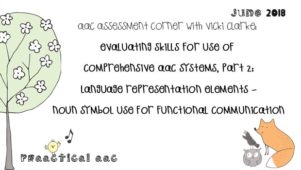
Vicki Clarke, CEO of Dynamic Therapy Associates and Director of DTA Schools, is back with another wonderful edition of AAC Assessment Corner. In addition to their clinic, Vicki and her team support school districts in AAC evaluation, equipment procurement, and implementation for individual students in the academic environment. DTA Schools also supports district-wide AAC implementation through the Classroom Communication Goals Project, training, and supporting all team members in classroom AAC implementation. In today’s post, Vicki shares her thoughts on how we can look at the use of AAC symbols for nouns as part of our evaluations for comprehensive AAC systems. You can view her previous contributions to the AAC Assessment Corner here. :::::::::::::::::::::::::::::::::::::::::::::::::::::::::::::::::::::::: Evaluating Skills For Use of Comprehensive AAC Systems, Part 2: Language Representation Elements – Noun Symbol Use for Functional Communication It was a crazy, busy month full of evaluations, trainings, and report writing. I’ve spent a lot of time with... [Read More...]
May 3, 2018
by Carole Zangari -
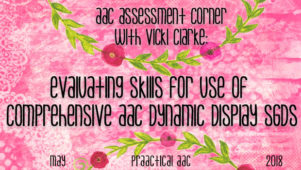
We’re always thrilled to share a guest post on AAC assessment practices from Vicki Clarke of Dynamic Therapy Associates. If you have questions about conducting AAC evaluations, read on. You can view her previous contributions to the AAC Assessment Corner here. :::::::::::::::::::::::::::::::::::::::::::::::::::::::::::::::::::::::::::::::::::: Evaluating Skills for Use of Comprehensive AAC Dynamic Display Systems Part I: Early Skills Over the past few years there has been an on-going discussion in the speech language pathology world about whether or not we needed to designate an official “specialty” recognition for augmentative and alternative communication practitioners. The argument goes something like this: It takes a lot of extra training, concerted effort in continuing education and daily practice in the assessment and implementation of augmentative communication to do it well. Therefore, we should have a “specialty area” in our national organization, ASHA, devoted to AAC. The counter-argument states that if our governing body says you need to... [Read More...]
October 19, 2017
by Carole Zangari -
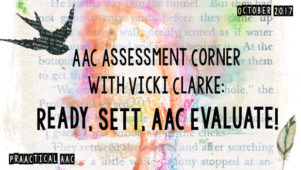
She’s bAACk! We couldn’t be happier to have another guest post on AAC assessment practices from Vicki Clarke of Dynamic Therapy Associates. In today’s post, she shares her tips and experiences for applying the SETT Framework to AAC assessment. If you are looking for information about how AACtual SLPs conduct their evaluations, Vicki’s posts are just what you need. You can view her previous contributions to the AAC Assessment Corner here. :::::::::::::::::::::::::::::::::::::::::::::::::::::::::::::::::::::::::::::::::::: Ready, SETT, AAC Evaluate! Last week I had the pleasure of joining the AAC After Work online conference hosted by Yapp Guru University. Jenna Coyer and I presented a session chatting about AAC assessment in emergent communicators. As we have worked to define our process for evaluation, we found ourselves repeatedly returning to the same approach our Assistive Technology teams use—the SETT Framework. The SETT Framework was developed by Joy Zabala as a process for making decisions about... [Read More...]
May 4, 2017
by Carole Zangari -
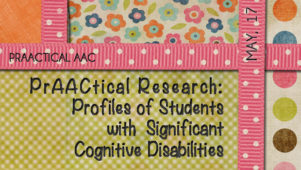
In today’s post, we welcome Dr. Kathy Howery who will be appearing here periodically to review some of the AAC research that is published in journals around the world. Kathy joins us from Alberta, Canada, and has worked in the field of assistive technology and special education for over three decades. Most recently she has completed her doctoral studies where she used phenomenological methods to seek understanding of the lived experience of speaking with/through a speech generating device. Kathy is currently working as consultant to schools and school districts across Alberta focusing primarily on children and youth with complex communication needs. In this first post, she helps us understand a study by Drs. Karen Erickson and Lori Geist published in the AAC journal last year. Enjoy! ::::::::::::::::::::::::::::::::::::::::::::::::::::::::::::::::::::::::::::::: Erickson, K. A. & Geist, L. A. (2016). The profiles of students with significant cognitive disabilities and complex communication needs. Augmentative and Alternative Communication,... [Read More...]
June 28, 2016
by Carole Zangari -
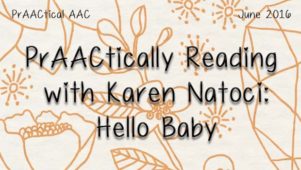
Karen Natoci is back with some wonderful suggestions for reading and building AAC skills with young children. Although her focus is on little ones with visual impairment, these books and the implementation suggestions, would be useful for a wide range babies, toddlers, and preschoolers who are developing their language skills. Enjoy! :::::::::::::::::::::::::::::::::::::::::::::: Books Hello Baby Words (high contrast board books) by Roger Priddy, illustrated by Holly Jackman (Published by St. Martin’s Press, 175 Fifth Avenue, NY 10010) Hello Baby Words: On The Go Hello Baby Words: Faces Hello Baby: Animals Hello Baby: Faces Core Vocabulary Focus: GO, GET, WHO, THAT, SEE, IT Fringe Vocabulary Transportation: digger, balloon, train, roller skates, helicopter, truck, car, submarine, rocket, dump truck, fire truck, boat, race car, tractor, car carrier, plane Animals: cat, turtle, fish, pig, butterfly, cow, mouse, bird, bear, zebra, rabbit, panda, penguin, dog, sheep, snake Faces: boy, girl, woman, man, grandfather, grandmother... [Read More...]
March 2, 2016
by Carole Zangari -

In this week’s video, we feature SLP Shannon Hennig who talks to us about some of her strategies for teaching language learners. As with her previous video, Shannon’s suggestions are clear, relevant, and prAACtical. Enjoy!
February 25, 2016
by Carole Zangari -
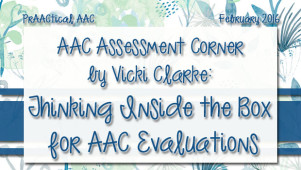
AAC assessment is a challenge in almost every service delivery setting, and many of you have reached out to us to ask for advice on how to strengthen your assessment practices. Luckily, Vicki Clarke, an AAC Chick who has a great deal of experience assessing learners in clinical and educational settings, has tips and resources to share. In this continuation of the AAC Assessment Corner series, Vicki talks about a key feature in any AAC system: vocabulary organization. ::::::::::::::::::::::::::::::::::::::::::::::::::::::::::::::::::::::::::::::::::::::::::::: Thinking Inside the Box for AAC Evaluations: What Type of Vocabulary Organization is Right For Your AAC User? Professionals often spend a great deal of time concerning themselves with which box they should get their AAC user. Should I pick a Prentke Romich or a Tobii Dynavox? But what about the iPad? And what about the money? Should I pick a CheapTalk or a GoTalk instead? Here’s the good news: The box is not the... [Read More...]
May 17, 2015
by Carole Zangari -
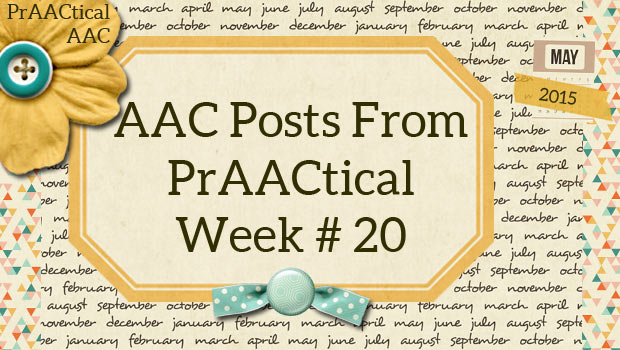
Monday – Sound/Music Cause and Effect Apps for Engaging AAC Learners Tuesday – Say What?!? AAC Assessment for Children Who Speak with Dr. Jill Senner and Matthew Baud Wednesday – Video of the Week: Communication Supports for Problem Behavior with Dr. Pat Mirenda Thursday – How I Do It: The All-in-One-Visual-Support Tool by Tabi Jones-Wohleber
April 30, 2015
by Carole Zangari -
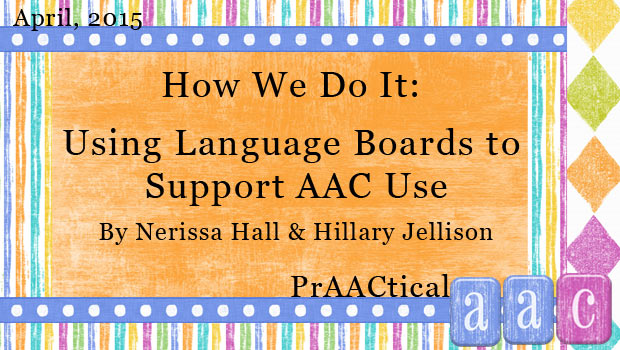
Many of you have reached out to say how much you’ve appreciated the prAACtical suggestions provided by Nerissa Hall and Hillary Jellison, New England-based SLPs and owners of Commūnicāre, LLC. We’re excited to have them back, especially because they are talking about something near and dear to our hearts: Implement a core vocabulary approach in their AAC therapy. In this post, they give us a peek into the ‘why’ and ‘how’ of making and using communication boards that are rich in core words. In their typically generous fashion, they also share templates for the boards that they make. How We Do It: Using Language Boards to Support AAC Use There are a number of different strategies one can use to support an individual’s use of augmentative and alternative communication (AAC). We know that aided language stimulation, augmented input, and AAC modeling are important and effective ways of supporting AAC use. By using... [Read More...]









